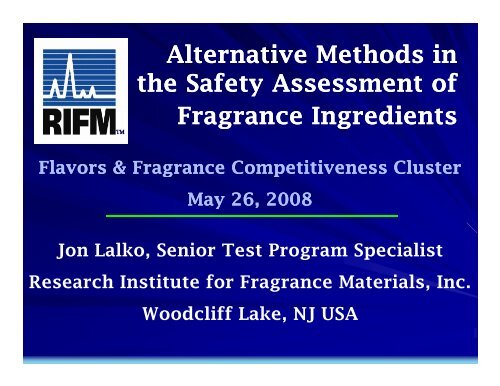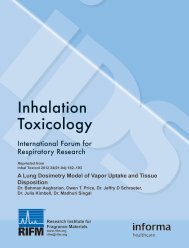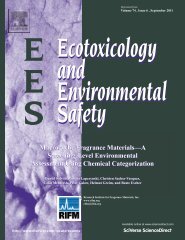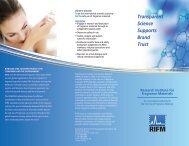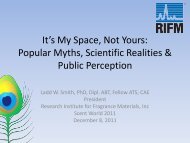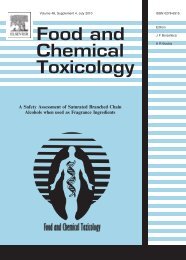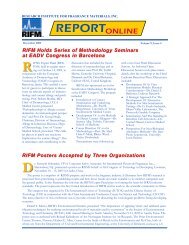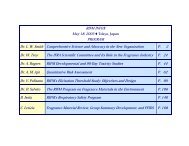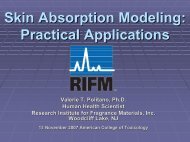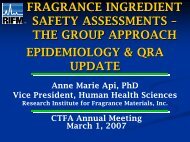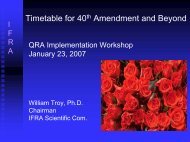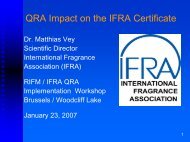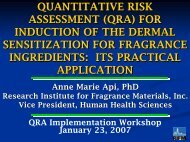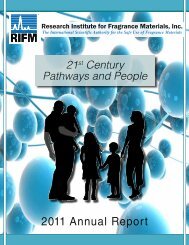Alternative Methods in the Safety Assessment of Fragrance Ingredients
Alternative Methods in the Safety Assessment of Fragrance Ingredients
Alternative Methods in the Safety Assessment of Fragrance Ingredients
You also want an ePaper? Increase the reach of your titles
YUMPU automatically turns print PDFs into web optimized ePapers that Google loves.
<strong>Alternative</strong> <strong>Methods</strong> <strong>in</strong><br />
<strong>the</strong> <strong>Safety</strong> <strong>Assessment</strong> <strong>of</strong><br />
<strong>Fragrance</strong> <strong>Ingredients</strong><br />
Flavors & <strong>Fragrance</strong> Competitiveness Cluster<br />
May 26, 2008<br />
Jon Lalko, Senior Test Program Specialist<br />
Research Institute for <strong>Fragrance</strong> Materials, Inc.<br />
Woodcliff Lake, NJ USA
RIFM VISION and MISSION<br />
To be <strong>the</strong> International Scientific Authority for<br />
<strong>the</strong> Safe Use <strong>of</strong> <strong>Fragrance</strong> Materials<br />
1. Engage <strong>in</strong> research and evaluation <strong>of</strong> fragrance<br />
materials through an <strong>in</strong>dependent Expert Panel<br />
2. Determ<strong>in</strong>e safety <strong>in</strong> use<br />
3. Ga<strong>the</strong>r, analyze and publish scientific <strong>in</strong>formation<br />
4. Distribute scientific data and safety assessment<br />
judgments to RIFM members, <strong>in</strong>dustry associations<br />
and o<strong>the</strong>r <strong>in</strong>terested parties<br />
5. Ma<strong>in</strong>ta<strong>in</strong> an active dialogue with <strong>of</strong>ficial<br />
<strong>in</strong>ternational agencies<br />
J Lalko - May 26 2008
<strong>Fragrance</strong> Product <strong>Safety</strong><br />
Member<br />
Companies<br />
Code <strong>of</strong><br />
Practice &<br />
Standards<br />
I<br />
F<br />
R<br />
A<br />
R<br />
I<br />
F<br />
M<br />
Research<br />
& Test<strong>in</strong>g<br />
J Lalko - May 26 2008<br />
REXPAN<br />
<strong>Safety</strong><br />
Evaluations
RIFM <strong>Safety</strong> <strong>Assessment</strong> Process<br />
<br />
Loss <strong>of</strong> Database key <strong>in</strong> vivo tools<br />
Move to <strong>Alternative</strong>s:<br />
Priorities<br />
Need to evaluate replacements<br />
Integrate new <strong>in</strong> vitro methodologies <strong>in</strong>to <strong>the</strong> process<br />
Exposure <strong>Assessment</strong><br />
Test<strong>in</strong>g<br />
REXPAN <strong>Safety</strong> <strong>Assessment</strong><br />
Communications<br />
IFRA Standard<br />
Publications<br />
RIFM Expert Panel <strong>Safety</strong> Evaluation Process Reg. Tox. & Pharm., 37 (2), 218-273, 2003<br />
J Lalko - May 26 2008
The shift to alternatives –<br />
Impact and challenges to risk assessment<br />
• There cont<strong>in</strong>ues to be significant challenges to <strong>the</strong><br />
fragrance <strong>in</strong>dustry to defend <strong>the</strong> safe use <strong>of</strong> materials<br />
<br />
Legislation (REACH, California)<br />
<br />
<br />
Scientific community y( (Publications)<br />
NGOs<br />
• Validated and accepted experimental tests are<br />
essential to answer<strong>in</strong>g <strong>the</strong>se challenges<br />
• Loss <strong>of</strong> key tools <strong>in</strong> <strong>the</strong> risk assessment process<br />
complicate our ability to successfully address<br />
questions<br />
‣ Result – A press<strong>in</strong>g need to identify suitable<br />
alternatives and determ<strong>in</strong>e how best to<br />
<strong>in</strong>tegrate <strong>the</strong>m <strong>in</strong>to <strong>the</strong> process<br />
J Lalko - May 26 2008
The shift to alternatives –<br />
What are <strong>the</strong> specific consideration for<br />
fragrance materials?<br />
• Will <strong>the</strong> test system be compatible/adaptable to our<br />
materials?<br />
Often concerns with solubility or volatility<br />
• Will <strong>the</strong> test system be relevant to fragrance<br />
exposure?<br />
Dermal and <strong>in</strong>halation<br />
• Will <strong>the</strong> test system be useful for complex mixtures?<br />
Essential oils<br />
J Lalko - May 26 2008
The RIFM Program –<br />
<strong>Alternative</strong>s Methodology Development <strong>in</strong><br />
Three Areas<br />
J Lalko - May 26 2008
Local Lymph Node Assay (LLNA<br />
LLNA)<br />
S<strong>in</strong>ce 2000, RIFM has used <strong>the</strong> LLNA almost exclusively for<br />
hazard and potency assessment <strong>of</strong> potential dermal sensitizers<br />
• Focused on cont<strong>in</strong>ued Ref<strong>in</strong><strong>in</strong>g <strong>of</strong> <strong>the</strong> assay….<br />
Development <strong>of</strong> <strong>the</strong> B220 endpo<strong>in</strong>t<br />
(dist<strong>in</strong>guish irritant vs. sensitization <strong>in</strong> <strong>the</strong> LLNA)<br />
Dr. Anne Marie Api – ICCVAM Review Panel<br />
• Us<strong>in</strong>g <strong>the</strong> LLNA as a bridge to develop Replacements ….<br />
Incorporat<strong>in</strong>g RIFM data <strong>in</strong>to publications provid<strong>in</strong>g a<br />
standardized dataset<br />
‣ Benefits – Work <strong>in</strong> this area will allow us to benchmark<br />
new methodologies for sk<strong>in</strong> sensitization<br />
J Lalko - May 26 2008
Johns Hopk<strong>in</strong>s University –Center for<br />
<strong>Alternative</strong>s to Animal Test<strong>in</strong>g (CAAT)<br />
• Dr. Ladd W. Smith - Industrial advisory board<br />
Review <strong>of</strong> proposals related to Replacement, Reduction and<br />
Ref<strong>in</strong>ement technologies (3Rs)<br />
• Support grants through CAAT:<br />
Gerberick et al. (P&G) ‘Gene expression changes as <strong>the</strong>y relate<br />
to <strong>the</strong> sk<strong>in</strong> sensitization potential <strong>of</strong> chemicals’<br />
Walker et al. (Iowa State University) ‘micr<strong>of</strong>luidics<br />
assay’<br />
Svensson et al. (University <strong>of</strong> Iowa) ‘Sk<strong>in</strong> explants for<br />
assessment <strong>of</strong> cutaneous reactions to xenobiotics’<br />
Benefits: 1) Steer<strong>in</strong>g alternatives research relevant to<br />
fragrance materials<br />
2) Collaborative <strong>in</strong>teraction with<br />
‘thought leaders’<br />
J Lalko - May 26 2008
Sk<strong>in</strong> Absorption -<br />
Experimental Studies<br />
• Historically, RIFM has utilized <strong>in</strong> vivo methodologies<br />
to <strong>in</strong>vestigate i <strong>the</strong> percutaneous penetration <strong>of</strong><br />
fragrance materials<br />
• RIFM has fully transitioned to human <strong>in</strong> vitro studies<br />
• A grow<strong>in</strong>g g <strong>in</strong> vitro dataset (recently published) has<br />
developed for key fragrance materials that will…<br />
1. Allow for comparative analysis based on structure and<br />
vehicle <strong>of</strong> adm<strong>in</strong>istration (important for group risk<br />
assessments)<br />
2. Assist <strong>the</strong> development and ref<strong>in</strong>ement <strong>of</strong><br />
ma<strong>the</strong>matical models<br />
J Lalko - May 26 2008
Sk<strong>in</strong> Absorption -<br />
Ma<strong>the</strong>matical Model<strong>in</strong>g<br />
• Collaborative work with Dr. Richard Guy (University<br />
<strong>of</strong> Bath, UK) to ref<strong>in</strong>e models <strong>of</strong> percutaneous<br />
penetration for fragrance materials<br />
• Model<strong>in</strong>g sk<strong>in</strong> absorption provides for…<br />
Fur<strong>the</strong>r alternatives to <strong>in</strong> vivo test<strong>in</strong>g<br />
Ability to generate <strong>in</strong>formation for an entire group <strong>of</strong><br />
materials<br />
Ability to identify materials that may require closer<br />
<strong>in</strong>spection<br />
‣ Benefits : 1) Methodology already <strong>in</strong>tegrated <strong>in</strong>to risk assessment<br />
2) In vitro/modeled sk<strong>in</strong> absorption data can<br />
guide exposure based development <strong>of</strong> o<strong>the</strong>r<br />
alternatives<br />
J Lalko - May 26 2008
In Silico Approaches<br />
• International QSAR Foundation<br />
• TIMES (Tissue Metabolism Simulator – Sk<strong>in</strong><br />
Sensitization)<br />
• MultiCase<br />
• In Silico approaches…<br />
Assist <strong>in</strong> build<strong>in</strong>g groups for risk assessment (justification<br />
for <strong>in</strong>clusion i and exclusion <strong>of</strong> molecules)<br />
l Help to identify relevant materials to test<br />
Will not be used <strong>in</strong> place <strong>of</strong> experimental tests for REACH<br />
‣ Benefits: 1) Rapid Screen<strong>in</strong>g – <strong>in</strong> practice we have done<br />
much <strong>of</strong> this ‘by hand’<br />
J Lalko - May 26 2008<br />
2) Support<strong>in</strong>g evidence for decision mak<strong>in</strong>g
Respiratory Program –<br />
5 Year Strategy<br />
IMMEDIATE<br />
GOALS<br />
(6 months)<br />
Conduct a<br />
comprehensive<br />
review <strong>of</strong> <strong>the</strong><br />
database for<br />
<strong>in</strong>halation data<br />
Develop<br />
<strong>in</strong>halation<br />
screen<strong>in</strong>g<br />
criteria for new<br />
and exist<strong>in</strong>g<br />
materials<br />
J Lalko - May 26 2008<br />
INTERMEDIATE<br />
GOALS<br />
~3 years<br />
Facet #1: Establish<br />
deposition/dosimetry<br />
pr<strong>of</strong>iles<br />
Facet #2: Replicate<br />
deposition/dosimetry<br />
pr<strong>of</strong>iles <strong>in</strong> vivo<br />
Facet #3: Conduct<br />
<strong>in</strong> vitro studies on<br />
isolated cell types<br />
LONG TERM<br />
GOALS<br />
3+ years<br />
Respiratory<br />
sensitization<br />
mechanism<br />
and method<br />
development<br />
Reaction<br />
chemistry and<br />
<strong>in</strong>door air<br />
quality
Respiratory Program –<br />
In Vitro Methodology Development<br />
• In vitro respiratory model system development<br />
Pilot program at Austrian Research Centers (ARC)<br />
• In vitro analysis <strong>of</strong> effects <strong>in</strong> lung cell l<strong>in</strong>es<br />
University <strong>of</strong> Medic<strong>in</strong>e and Dentistry <strong>of</strong> New Jersey (UMDNJ)<br />
• Peptide Reactivty and Dendritic Cell Activation –<br />
Dermal vs. Respiratory Sensitizers<br />
University <strong>of</strong> Manchester and P&G<br />
‣ Benefits: 1) D l t d i d t ifi ll dd th<br />
Benefits: 1) Development designed to specifically address <strong>the</strong><br />
needs <strong>of</strong> fragrance <strong>in</strong>gredients<br />
2) Program will address <strong>the</strong> press<strong>in</strong>g need to<br />
fill data gaps<br />
J Lalko - May 26 2008
Environmental Program –<br />
In Vitro Methodology Issues<br />
• Regulatory pressure to avoid/elim<strong>in</strong>ate<br />
i vertebrate test<strong>in</strong>g, <strong>in</strong>clud<strong>in</strong>g fish tests<br />
• This would affect both risk assessment (fish<br />
acute and chronic studies) and hazard<br />
assessment (bioaccumulation test<strong>in</strong>g)<br />
• Presently, unclear if fish studies are banned<br />
under <strong>the</strong> deadl<strong>in</strong>es established <strong>in</strong> <strong>the</strong><br />
Cosmetics Directive (7th Amendment)<br />
J Lalko - May 26 2008
• Research:<br />
Environmental Program –<br />
In Vitro Methodology Issues<br />
HESI Bioaccumulation Project<br />
OECD Toolbox<br />
• Interactions:<br />
Dr. Daniel Salvito - SETAC Bioaccumulation<br />
Science Advisory Group<br />
Active <strong>in</strong> SETAC’s advisory group on animal<br />
alternatives<br />
‣ Benefits: Similar to those we have discussed previously…<br />
J Lalko - May 26 2008<br />
- Development relevant to fragrance materials<br />
- Data will address need to fill data gaps<br />
- Provide <strong>in</strong>dustry a ‘Voice at <strong>the</strong> Table’
J Lalko - May 26 2008<br />
Timel<strong>in</strong>e -
Challenges Ahead<br />
• Select<strong>in</strong>g <strong>the</strong> relevant methodologies<br />
• Develop<strong>in</strong>g , Evaluat<strong>in</strong>g and Optimiz<strong>in</strong>g those assays<br />
for use with fragrance materials<br />
• Assur<strong>in</strong>g gg<br />
general consensus <strong>in</strong> <strong>the</strong> scientific and<br />
regulatory community (Not just a RIFM Problem,<br />
significant hurdle)<br />
• Integration <strong>of</strong> result<strong>in</strong>g assays <strong>in</strong>to a uniform risk<br />
assessment process<br />
‣ There will need to be significant ifi collaboration with<br />
those both <strong>in</strong>side and outside <strong>of</strong> <strong>the</strong> fragrance<br />
<strong>in</strong>dustry to be successful<br />
J Lalko - May 26 2008
Conclusion and Perspective –<br />
• New <strong>in</strong> vitro methods can provide an<br />
advantage over those <strong>the</strong>y replace<br />
More relevant (Human based cells and biology)<br />
More efficient (Higher throughput)<br />
More cost effective (Employee time, raw materials,<br />
physical plant)<br />
J Lalko - May 26 2008
MORE INFORMATION<br />
Research Institute for<br />
<strong>Fragrance</strong> Materials, Inc.<br />
Tel.: +1 201-689<br />
689-80898089<br />
jlalko@rifm.org<br />
RIFM: www.rifm.org<br />
IFRA: www.ifraorg.org<br />
J Lalko - May 26 2008


